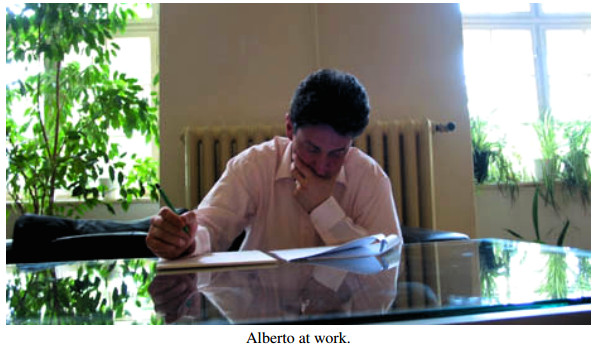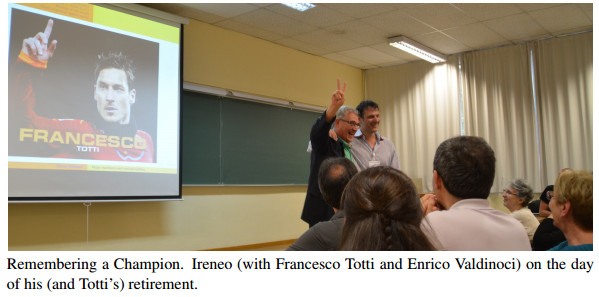This special issue at a glance
Besides being a champion of chess and of des chiffres et des lettres, during the first fifty years of his life Alberto Farina has also left a permanent trace in partial differential equations. We are all familiar with his depth of thought and recognizable style and it would be virtually impossible to recall and comment on all his fundamental contributions in different areas.
To cut a long story short, we just mention that the articles by Alberto for which MathSciNet lists more than fifty citations (at least one per year of Alberto's life) cover in depth a broad spectrum of partial differential equations, including:
● one-dimensional symmetry of entire solutions, inspired by a celebrated conjecture by Ennio De Giorgi [24,28,31],
● overdetermined boundary value problems [23,32],
● Liouville-type theorems for solutions of the Lane-Emden equation [12,25] and of general semilinear equations [21],
● non-existence results for Liouville-type equations [14,26].
We also know how proud Alberto is of his papers written with James Serrin [29,30], in which they have creatively looked at the class of quasilinear elliptic equations with the property that any entire solution must necessarily be constant (of course, the simple Laplace equation does not belong to this class, but the family of equations considered includes the p-Laplacian and the mean curvature equations with appropriate weights).
Among all the problems studied by Alberto, one of his favorites is probably De Giorgi's Conjecture [15]. This is the problem, in the original statement by De Giorgi:
Let us consider a solution u∈C2(Rn) of
such that |u|≤1, ∂u∂xn>0 in the whole Rn. Is it true that, for every λ∈R, the sets {u=λ} are hyperplanes, at least if n≤8? (This problem is related to [40,41]).
In this editorial, we do not dive into the full story of De Giorgi's Conjecture (for this, see [31] and the references therein). Rather, we recall some of the very many results obtained by Alberto on this topic, also in relation with p-Laplace operators
and the mean curvature operator
For the sake of brevity, we will say that "u is one-dimensional" when the claim in De Giorgi's Conjecture holds true (notice indeed that this claim is equivalent to the possibility of writing u as a function of only one variable).
Several ideas stemmed out from Alberto's "Habilitation à diriger des recherches", especially in connection with the notion of "stable" solutions: namely a solution of an equation with a variational structure is called stable if the second derivative of the corresponding energy functional is nonnegative definite. Not only is this a natural condition to consider from the perspective of the calculus of variations (for instance, local minima satisfy this condition). It is also strictly related to the geometry of the solution, as indeed solutions satisfying the monotonicity assumption in the statement of De Giorgi's Conjecture can be proved to be stable.
In this setting, a special case of [28,Theorems 1.1 and 1.5] gives that:
Let Nu be either the p-Laplace operator in (1) for some p≥1 or the mean curvature operator in (2).
Let u∈C1(R2)∩C2({∇u≠0}), with ∇u∈L∞(R2)∩W1,2loc(R2), be a stable weak solution of Nu=f(u) in R2, where f is a locally Lipschitz function.
If Nu is the p-Laplace operator with p∈[1,2), assume additionally that {∇u=0}=∅.
Then, u is one-dimensional.
Notice that this is a more general case than De Giorgi's Conjecture in dimension 2.
Moreover, a special case of [28,Theorem 1.2] gives that:
Let Nu be either the p-Laplace operator in (1) for some p>1 or the mean curvature operator in (2).
Let u∈C1(R3)∩W1,∞(R3) be a stable weak solution of Nu=f(u) in R3, where f is a locally Lipschitz function.
Assume additionally that {∇u=0}=∅ and ∂u∂x3≥0.
Then, u is one-dimensional.
Notice that this is a more general case than De Giorgi's Conjecture in dimension 3.
One typical feature of Alberto's work is also to relate the symmetry properties of a solution to the geometry of the solution's profiles at infinity. In particular, the monotonicity assumption in the statement of De Giorgi's Conjecture allows one to define the two profiles
where the notation (x′,xn)∈Rn−1×R has been used.
In this setting, it follows from a particular case of [33,Theorem 1.1] that one can deduce the symmetry of the solution from the symmetry of the profiles. For this, one says that a function is "two-dimensional" when it can be written as a function of at most two variables, and we have that:
Let p∈(1,+∞) and u∈W1,ploc(Rn) be a weak solution of
such that |u|≤1, ∂u∂xn>0 in the whole Rn.
Suppose that both ¯u and u_ are two-dimensional.
Then, ¯u is identically +1, u_ is identically −1 and u is a local minimum of the energy functional.
Also, if n≤8, then u is one-dimensional.
We observe that this statement when p=2 proves De Giorgi's Conjecture, under the additional assumption that the limit profiles are two-dimensional.
Another very recognizable line of investigation consists in deducing symmetry results from the knowledge of the shape/geometry of a level set of the solution. As an example, one can obtain a symmetry result under the assumption that "one level set is a complete graph", meaning that there exist λ∈R and Γ:Rn−1→R such that
We remark that this graphicality condition is compatible with the monotonicity assumption in De Giorgi's Conjecture, but it is not ensured by it. In this setting, from [33,Theorem 1.3] one obtains the symmetry of the solution if one level set is a complete graph:
Let us consider a solution u∈C2(Rn) of
such that |u|≤1, ∂u∂xn>0 in the whole Rn.
Assume that one level set of u is a complete graph.
Then, ¯u is identically +1, u_ is identically −1 and u is a local minimum of the energy functional.
Also, if n≤8, then u is one-dimensional.
See also [35] for related results based on the limit interface of the solution.
A problem strictly related to De Giorgi's Conjecture embraces the case in which the solution attains the limits +1 and −1 at infinity in a uniform way. In this case, the problem is often named Gibbons' Conjecture, after theoretical physicist Gary William Gibbons. In his seminal paper [24], Alberto gave a positive answer to Gibbons' Conjecture in every dimension (the same result was obtained independently and with different methods in [4,5]):
Let u∈C2(Rn) be a bounded solution of
in Rn such that
Then, u is one-dimensional.
See also [34] for related results in more general settings.
De Giorgi's Conjecture is also closely related to Liouville-type results. To showcase this link, we recall for instance [21,Theorem 1.1]:
Assume that f∈C1(R), f≤0 and n≤4. Let u∈C2(Rn) be a bounded and stable solution of
Then, u is constant.
This result has been recently sharpened in [22,Theorem 1] for dimension n≤10 (addressing also the case of solutions that are assumed to be only bounded from below). See [25,26] also for classification results with power-type nonlinearities, sign-changing and unbounded solutions, etc. The case of exponential nonlinearities is also addressed in [14].
Recently, a great attention has been devoted also to a nonlocal variant of De Giorgi's Conjecture in which the Laplace operator is replaced by the fractional Laplacian, defined, for s∈(0,1), up to normalizing constants, as
with the integral computed in Cauchy's Principal Value sense.
This type of problems is interesting also in connection with long-range phase transitions and, for s∈(0,12), which is often referred to as the "genuinely nonlocal regime", is related to the theory of nonlocal minimal surfaces (see [20] for further details).
One of the works by Alberto also settles this problem in dimension 3 for the genuinely nonlocal regime. Indeed, from [19,Theorem 1.1] we have that:
Let n≤3 and s∈(0,12). Let us consider a solution u∈C2(Rn) of
such that |u|≤1, ∂u∂xn>0 in the whole Rn.
Then, u is one-dimensional.
We also observe that in the original formulation by De Giorgi, the problem was explicitly related to the study of minimal surfaces via the reference to [40,41]. This intimate connection is reflected into many of Alberto's works, in which the symmetry properties of solutions of partial differential equations are linked to Bernstein-type results classifying entire graphical solutions of geometric equations.
In this respect, many of the works by Alberto are connected with the Bernstein problem and, as an example, we recall here [27,Theorem 1.1]:
Assume that n≥8 and let u∈C2(Rn) be a solution of the minimal surface equation
If n−7 partial derivatives of u are bounded on one side (not necessarily the same), then u is an affine function.
This result is sharp, since one can also construct examples of non-affine solutions in dimension n≥8 with n−8 partial derivatives that are bounded on one side.
We also mention that a version of this result dealing with nonlocal minimal surfaces has been obtained in [11].
We hope that this special issue reflects Alberto's tastes and scientific passions, also covering a variety of research directions. Though it is simplistic to try to frame these directions into stiff categories, the articles collected in this volume do, in our opinion, overlap with many of Alberto's main interests and include fundamental topics, such as:
● rigidity, symmetry and classification results [3,6,7,13,16,36,39],
● regularity theory [9,17],
● nonlocal equations [1,2,8,10],
● topical applications [18,37,38].
On a sad note, in the period of time in which this special issue was launched and completed, the great figure of Ireneo Peral has left us. Tragically, his contribution to this special issue [2] will remain as one of his last works. We will miss Ireneo and we will always remember his brilliance, enthusiasm and generosity.
But on a positive note, Ireneo has not left us alone and many of his disciples, friends and collaborators are putting together a new special issue commemorating Ireneo's prominence. In a sense, we are happy to pass the baton to this incoming special issue, which we see as a prolongation of Ireneo's marvelous and unique scientific matrice.
Acknowledgments
We thank all the authors and all the referees for their invaluable contributions.
SD has been supported by the Australian Research Council DECRA DE180100957 PDEs, free boundaries and applications.
Conflict of interest
The authors declare no conflict of interest.
















 DownLoad:
DownLoad: